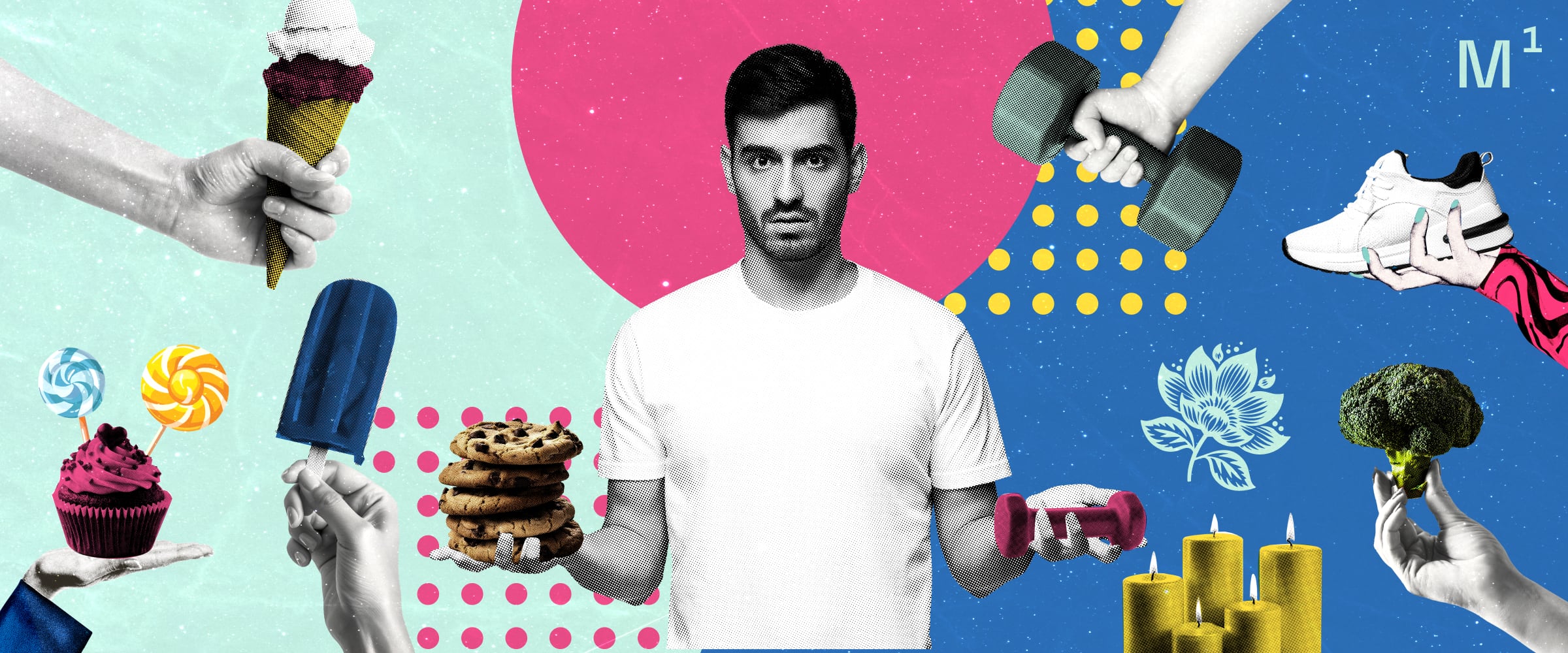
Being Good by Being Bad: Converting Gen Z Wellness Barriers into CPG Entry Points
For established CPG brands—particularly in snackable food and beverage, those daily indulgences that bring joy to people’s lives—connecting with Gen Z can feel like speaking a foreign language without a translator.
The meticulously crafted campaigns that resonated with generations of consumers now slide right past Gen Z, leaving your marketing team exasperated and your C-suite questioning the investment. But as 25% of the world’s population, with spending power projected to be $12T by 2030, they can’t be ignored.
The problem isn't that Gen Z doesn't indulge, of course—they absolutely do. But they've written their own rules for when and why indulgence occurs.
Previous generations integrated small indulgences into daily life without a second thought. Gen Z has created a framework where wellness and indulgence exist in tension.
While Gen Z posts their green smoothies and workout routines on Instagram, they stress-eat behind closed doors. They’ll track macros and meditation streaks by day, then seek out full-calorie, full-flavor experiences late at night when life pressures overwhelm them.
This isn't hypocrisy. It's a sophisticated system of inner permission-giving that CPG can recalibrate—and leverage—to win Gen Z without reformulating a single product.
The answer lies in understanding the pull of personal values and the behavioral science principles that can free a generation to love your product in the light of day—turning Gen Z’s apparent wellness barriers into their strongest category entry points.
Lost in Translation: Why Traditional Campaigns Celebrating Small Pleasures Doesn’t Connect with Gen Z
As “the wellness generation,” Gen Z feels extraordinary pressure to make food and beverage choices that align with their identity and values. Yet this very source of anxiety makes indulgence more necessary and more guilt-inducing.
According to McKinsey's Future of Wellness report, Gen Z is now purchasing more wellness products and services than every older generation except Millennials. This interest is more than casual—it's a defining characteristic of their identity, spending patterns and intended way of life. A remarkable 56% of Gen Z consumers say personal fitness is a "very high priority.”
This focus on wellness extends to their food choices:
- 65% of Gen Z report wanting a more plant-forward diet
- 79% choose to go meatless at least once a week
- They’re the generation most likely to eat a piece of fruit every day
Yet look beneath these good habits and aspirations, and you'll find a generation that feels under unprecedented pressure—and believes they are failing.
Gen Z reports the highest stress levels of any generation, with 33% describing themselves as "very stressed" (compared to just 10% of Boomers). And tellingly, despite their wellness focus, they rate their own health as “good” or “very good” at the lowest proportion of all demographics. In their own minds, at least, they do not live up to their ideals.
These emotions and beliefs then drive distinct snacking habits—think pleasure drenched in guilt:
- Gen Z consumers are more likely than any other generation to say they “always” or “often” eat to manage negative emotions, and then to feel guilty about it
- When they engage in this stress-related consumption, 6 in 10 say they turn to unhealthy food/drink, likely because they associate it with greater sensory appeal
The most revealing insight? When asked what benefits they seek from food and beverages, Gen Z stands alone as the only generation to list emotional and mental health in their top three priorities.
This is a generation that seeks more than nutrition; they're looking for psychological relief, caught between wellness aspirations and emotional eating realities.
Is it any surprise that traditional CPG campaigns and promotions that ignore this tension—or try to resolve it through health claims that are dubious at best—fall flat?
How Behavioral Science Can Help Brands Connect
Gen Z’s contradictions aren’t as impossible for brands to navigate as they might seem. Behavioral science, the study of why humans do what they do, sheds fascinating light on how to engage them in ways they won’t scroll past but actually welcome.
In a recent episode of the behavioral science for Brands Podcast, hosts Richard Shotton (behavioral science expert) and MichaelAaron Flicker (founder of Method1) discussed two powerful behavioral principles that CPG can apply when targeting Gen Z.
Moral Licensing: The "I Earned This" Effect
Moral licensing is that all-too-human tendency to give ourselves permission to indulge when we've been virtuous. After doing something "good," like going to the gym, we feel entitled to do something "bad"—without the guilt.
Researcher Wen-Bin Chiou demonstrated this principle in a revealing study[i] with smokers. Participants received sugar pills, but half were told they were taking multivitamins while the others knew they were taking placebos. The results? The "vitamin" group exercised less, smoked more and made less healthy choices across the board.
The mere belief they'd done something healthy gave them permission to indulge.
For CPG brands, this insight offers the chance to become something more positive in Gen Z's life than a guilt-inducing midnight snack. Crucially, it requires making no change to your product—only how it fits into Gen Z's health-first mindset (and workout schedules).
Present Self vs. Future Self: How Timing Shapes Choice
Shotton and Flicker also highlighted a second behavioral principle that can help brands engage Gen Z without triggering the guilt that typically shadows their indulgence.
It turns out people make very different decisions based on timing.
In another landmark study[ii], researcher Daniel Read offered participants a simple choice: an apple or a chocolate bar. When choosing something to eat immediately, 70% chose the immediate gratification of chocolate (who could blame them?). But when asked what they'd want to receive a week later, the pattern reversed—75% chose the apple, or health.
For Gen Z, who already feel guilty about stress-eating, this principle offers brands a potent way in.
Gen Z deeply values mindful consumption, always wanting to live their values. By aligning campaigns with what they’re actually thinking about indulgence at the moment of choice, brands can actively support Gen Z’s desire for intentional decision making.
Three Approaches for Making Gen Z’s Relationship with Your Product Healthier
These principles aren’t theoretical. They reveal possibilities for CPG brands to engage Gen Z and make their connection with indulgent products more authentic and less fraught.
Here are three approaches, each drawing on the behavioral science we've explored, that can dramatically change how Gen Z perceives your place in their wellness-focused world.
1. Position as the Reward, Not the Routine
Position your products as prizes for Gen Z’s wellness efforts rather than the evidence of their failure. Don't resist wellness culture—ride its wave and acknowledge what Gen Z wants: a guilt-free reward for having lived their values faithfully for days or even hours.
Strongbow cider's "Earn It" campaign exemplifies this strategy. They don’t claim to be a health drink. Instead, they celebrate that their customers have "crushed" their day and deserve a moment of indulgence, leveraging moral licensing to position their cider as an indulgence that’s well-deserved.
For brands looking to adopt this approach, visuals can connect achievements with moments of well-considered reward, and messaging can transform what might have been guilt into a sense of balance and psychological health.

2. Optimize for the Purchase Moment
The present self vs. future self principle creates opportunities to meet Gen Z where they are across purchase contexts—helping them navigate the heightened tension between their emotional needs and healthy ideals:
- Immediate consumption channels (convenience stores, vending machines, checkout aisles) can emphasize emotional benefits while positioning the indulgence as an earned indulgence
- Future purchase channels (meal planning apps, online or retail grocery) can acknowledge wellness goals while subtly emphasizing portion control or delayed gratification, positioning your product as the reward they'll deserve later
KitKat's iconic "Give Me a Break" campaign succeeds by focusing on moral licensing in the moment, at POP. It doesn't try to rationalize being on your weekly shopping list. Instead, it positions itself as the perfect antidote to current stress or work pressure.

This channel and moment-specific approach transforms your brand from something Gen Z regrettably consumes in moments of weakness into something they thoughtfully incorporate into a balanced lifestyle.
3. Target Moments When Gen Z Has Been Good
Perhaps the most direct application of moral licensing is reaching Gen Z immediately after virtuous behavior—when they're psychologically primed to treat themselves.
Starbucks' app and location strategy achieves this brilliantly. The app sends "pick-me-up" suggestions just when users are hitting that post-lunch slump in their workday—right when they feel they've accomplished enough to deserve indulgence.

Their integration with Target's drive-up pickup applies the same psychology: "You adulted by doing your shopping; here's a treat for being responsible."
For brands intrigued by this approach, media can be deployed to reach Gen Z immediately following wellness activities. Think geo-targeted mobile campaigns around gyms or health food stores, or digital campaigns that surface at the end of a long day at work.
Becoming Irresistible by Speaking To—Not Past—Gen Z
By understanding both behavioral science and Gen Z's complex relationship with indulgence, CPG indulgence brands can transform what seems like an insurmountable language barrier into a meaningful conversation.
These principles do more than help brands speak to Gen Z. They position your product in the wellness narrative they're already writing for themselves.
The good news for established CPG is that each recommended approach preserves what existing customers already love about your brand—your product formulas, your distinctive assets, your core identity. You're not changing what you offer; you're evolving how you frame it.
For your core shopper, nothing changes. For Gen Z, everything does.
These approaches are also imminently testable. You can deploy the behavioral science principles in controlled environments first—a single campaign, a regional market or a digital-only initiative—to measure effectiveness before scaling. Simple A/B testing of new messaging will tell the story of whether you’re creating a Gen Z entry point or not.
The brand and business impact can be substantial:
- Immediate performance gains: When your messaging aligns with how Gen Z wants to make decisions, you accelerate them toward choice, increasing the likelihood of conversions across both digital and physical retail
- Long-term brand building: By positioning your indulgence brand as a part of a balanced way of life rather than a source of regret, you build lasting relevance and become a pantry staple for intentional enjoyment
- Enduring competitive advantage: While competitors debate product reformulations or chase wellness fads, you apply behavioral science to meet Gen Z's psychological needs—creating a deeper human connection that outlasts trends
The achievable goal for CPG indulgence brands is to make your brand irresistible to Gen Z: something they instinctively welcome into their lives even if they can’t articulate why–something that becomes their indulgence of choice.
The key is to master Gen Z’s language of psychological permission, supporting their authentic decision-making and respecting their need to believe they’re being good … even when they indulge.
[i] Chiou, W.-B., Wan, C.-S., Wu, W.-H., & Lee, K.-T. (2011). A randomized experiment to examine unintended consequences of dietary supplement use among daily smokers: Taking supplements reduces self-regulation of smoking. Addiction, 106(12), 2221–2228. https://doi.org/10.1111/j.1360-0443.2011.03545.x
[ii] Read, D., & van Leeuwen, B. (1998). Predicting hunger: The effects of appetite and delay on choice. Organizational Behavior and Human Decision Processes, 76(2), 189-205.https://doi.org/10.1006/obhd.1998.2803
To see behavioral science principles in action, explore Method1’s work.
To learn more about how brands can tap moral licensing to drive performance and create brand value, listen to Episode 44 of the behavioral science for Brands Podcast (official podcast of the Consumer Behavior Lab) here.
Ready to
make your brand
irresistible?
